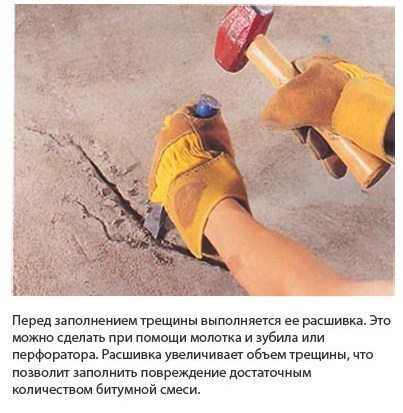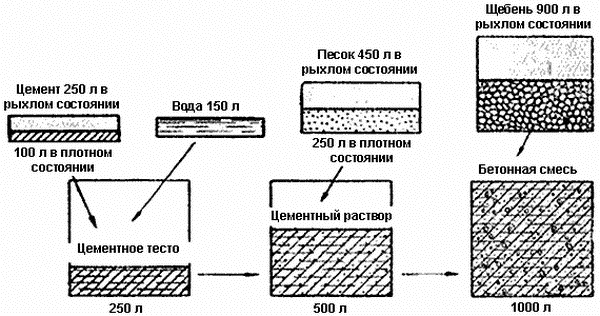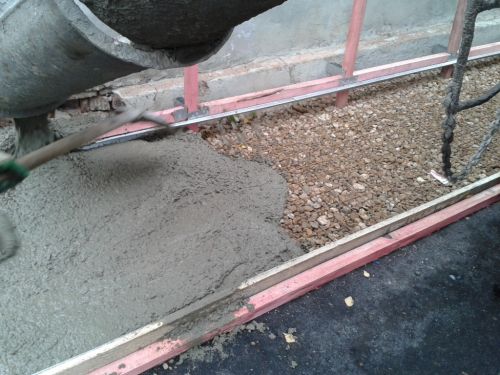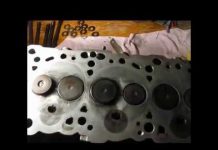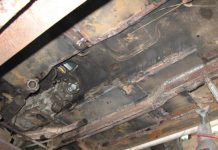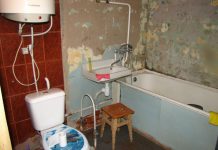In detail: do-it-yourself cement repair of the blind area around the house from a real master for the site my.housecope.com.
A reliable, time-tested way to protect the foundation from the effects of surface water is the construction of a concrete blind area around the house. The undoubted advantage of the concrete blind area is its low cost and ease of manufacture.
No material can guarantee 100% moisture protection, which is provided by a concrete blind area with an integral coating (without arranging a multi-tiered "pie"). The condition of the foundation is directly reflected in the position of the entire structure. Therefore, the foundation needs capital protection.
This is precisely the main task of the blind area - to protect the foundation and basement of the house. In addition to the barrier, it has several other functions. For example, it allows you to organize more convenient movement along the blind area and gives the structure a finished appearance.
| Video (click to play). |
Let's consider step by step how to correctly make a blind area around the house of concrete with your own hands. We propose to break down all the stages of the arrangement into theoretical and applied.
- In the first part, we will analyze what you need to know and prepare before starting work.
- In the second, how to prepare the bed and correctly fill the concrete blind area.
- concrete blind area width, according to SNiPu 2.02.01-83 should be 200 mm. more than the overhang of the roofing material. If there is a drain, its parameters are also taken into account. The same SNiP regulates the width depending on the type of soil. The traditional (optimal) width of the blind area can be considered 1 meter. This width provides freedom of movement and plays the role of a path around the house;
- length... Since the foundation needs protection around the entire perimeter of the house, it is logical that the blind area should also completely encircle the structure. The only exception can be the installation site of the concrete porch;
| Video (click to play). |
- depth or level of the blind area should not exceed half of the estimated depth of soil freezing characteristic of a particular region. This parameter can be viewed in the table or request information in the architecture department at the location of the object.
The ability of the concrete blind area to move with the soil gives it its functions. Otherwise, its role will be reduced to water drainage, which is not enough to protect the foundation.
Note. The depth of freezing is affected by the presence of communications in the soil.
Armed with the above data, you can proceed directly to the construction of the concrete blind area of the foundation.
- concrete for the blind area. The brand is an indicator of the quality of concrete, its value ranges from 100 to 1000. It indicates the proportion of the cement content in the concrete. The class of concrete ranges from B3.5 to B8 and denotes the strength of the concrete. So, class B 15, indicates that a cube of concrete pouring 15x15x15 cm in size is able to withstand a pressure of 15 MPa.
What brand of concrete is needed for the blind area? To prepare the solution, cement grade M 200 (class B15) is used.
The parameters (properties) of concrete, depending on the brand, are shown in the table.
- sand. Which one do you need? For the device of the lower layer of the pillow, river or quarry sand is suitable. The main thing is that it does not contain large impurities that can damage geotextiles;
- crushed stone (gravel). For the blind area, crushed stone of fraction 10-20 is suitable;
- clay or geotexile for the installation of a hydraulic lock. In practice, this layer is absent in the base cushion, because concrete removes water well;
- iron cement.
If it is not possible to use ready-made concrete, you can knead it yourself. To do this, you need to prepare:
- cement for the blind area. You should know that the grade of concrete is determined by the grade of cement and its specific gravity as a percentage of the components of the solution. For the blind area, M400 Portland cement is used. The cement must be fresh; with every month of storage, it loses 5% of its properties. It is simple to check the freshness, it is enough to squeeze a little cement in your fist, if it shrinks into a lump - its shelf life is running out, if it crumbles freely, you can work with it;
- sand. To prepare concrete, you need to take sifted and washed from impurities and soil;
- crushed stone. It is advisable to use crushed stone with a fraction of 5-10 mm. Moreover, crushed stone is better than, for example, small pebbles;
- water. Should be at room temperature;
- additives. Needed in order to give concrete frost-resistant properties. Liquid glass is often used as an additive.
From the tools you will need a concrete mixer or a container for mixing, a shovel, a bucket (it is better to take a plastic one, it is easier to wash it), a measuring container (for water), a manual ramming log or a vibration plate.
In practice, the solution for the blind area is prepared in portions, after all the preparatory work has been completed. We will give a ready-made recipe for cement mortar and how to mix it correctly.
The composition of the concrete solution includes: cement, crushed stone, sand, water and various additives that increase its strength. The durability and strength of the blind area depends on the ratio (proportions) of these components.
Note. Components are measured by weight only.
The destruction of the blind area around the building, the appearance of cracks and the germination of vegetation in them under the influence of time is a common occurrence. Especially if the coating was laid in violation of construction technology. If the problem is obvious, then repairing the blind area near the house with your own hands or with the involvement of competent workers must be carried out promptly, since the blind area has an important role to play - protecting the foundation from the penetration of precipitation and the formation of damage during severe frosts.
A blind area is a covering around a building with an average width of 80 to 150 cm, which protects the foundation from moisture and freezing... It is equipped with a certain slope to ensure the drainage of rainwater from the house. According to construction standards, the slope should be 5-10 cm for each meter of the blind area, while the edge adjacent to the wall of the house should rise, and the opposite should be level with the ground.
The lathing for pouring concrete during the repair of the blind area begins to be made from the lowest place, that is, from the point where the water is drained.
Then they move to the opposite side of the house, constantly monitoring the level of the slope.
The materials used to equip the protective structure with your own hands are:
- concrete;
- cement;
- artificial and natural stone;
- paving stones;
- asphalt;
- tile.
To repair the coating around the house with your own hands you will need:
- shovel;
- bucket;
- wheelbarrow;
- puncher;
- materials for heat and moisture insulation;
- building level;
- sand;
- crushed stone;
- fittings.
Step 1. Preparation for pouring the solution.
Before carrying out the main work, the surface of the old coating should be cleaned from dust and dirt. Expand cracks and remove completely destroyed areas. Prime the edges of cracks to improve adhesion. To close the gaps that have formed, to save cement mortar, you can use pieces of the old destroyed blind area. To do this, they are laid out there before pouring.
The stage of preparing the blind area for pouring the solutionStep 2. Preparation of the solution.
For this, the following ingredients are used: sand - 2.6 parts, cement M500 or M400 - 1 part, crushed stone - 4.5 parts, water - 125 liters per 1 cubic meter. ready-made solution, as well as other additives. The shelf life of the finished mixture is about 2 hours.
Preparation of a solution for repairing the blind areaIt is better to start pouring concrete from the highest point, periodically monitoring compliance with the planned slope. Repair of large areas of damaged blind area should be carried out using a reinforcing mesh.
The third step is pouring concrete.After pouring, the concrete is compacted and leveled.
After completion of the work, the surface is covered with a damp cloth and left to dry gradually, occasionally sprinkling with water, so that the concrete does not dry out too quickly and does not crack.
After complete drying of the concrete, the formwork is removed.
- Lack of a waterproofing layer. This is an important structural element that separates all other layers from the ground and prevents the penetration of moisture from the outside.
- Poorly compacted, uneven backfill. Insufficient thickness of the top layer.
- Construction work under unfavorable climatic conditions. According to the technology, it is impossible to carry out such work on the eve of frost, in the heat, before the onset of rains. All these factors will have an extremely negative effect on the quality of the coating, disrupt the process of solidification and germination of cement crystals.
- Lack of expansion joints. Multiple temperature changes throughout the year lead to expansion, compression, frost heaving of the soil, which increases the likelihood of destruction of the concrete structure. To prevent this from happening, expansion joints should be placed in it, which can partially compensate for these phenomena. Usually they are placed every 1.5-2 meters in order to distribute the emerging vibrations, but less is possible.
The strength and durability of the foundation, as well as the absence of unplanned spending of time and money for repairs, depends on the quality of the concrete structure, made in compliance with the technology. It is easier to do everything once with your own hands in accordance with the established norms than to deal with the consequences of incorrect laying of the coating all the time.
The blind area is an indispensable part of regularly used objects. It is a protective structure that is located along the perimeter of the building and is designed to eliminate the penetration of moisture into the basement and foundation. But over time, the owners think about how to repair the blind area near the house, which we will talk about below.
Blind areas can be viewed as an added precaution to protect the foundation structure from damage. They are built from artificial and real stone, paving slabs, concrete, cement. Unequal tiles are in demand, asphalt and other materials are rarely used.
The integrity and strength of the blind area are important factors ensuring the performance of its functions. Unequal in complexity and scale of destruction, which with some period appear in it, is the lot of not only old buildings, but also fairly new buildings.
Many situations provide some kind of influence on this state: from the peculiarities of the climate of the area where the building is located, and to errors in construction technology.
Regardless, it is important to repair problem areas. In almost all cases, this can be done by hand. It is worth starting with a visual examination and finding the reasons, and only then take on the repair of the blind area near the house.
Reasons for the formation of blind area deficiencies
Blind area defects often appear in the form of deep or superficial cracks, displacement and subsidence of some parts in relation to each other, chipping of some edges or areas.
Peeling of the slab from the base is also possible. To understand why this happened, and what factors actually became the basis for such a destruction of the blind area, makes it possible to make a good repair and not return to this for years.
It should be noted right away that the reasons can be of all kinds, and we will consider the most popular of them.
Violation of laying technology
This includes the lack of hydroprotection in the "pie", designed to separate the soil from the structure and exclude the penetration of moisture from the soil layers.
Another row is backfill. Its looseness and unevenness leads to unstable facial coverage, in other words, it becomes vulnerable.
Violation of the norms, and specifically the discrepancy in width and depth, causes destruction in the thickness of the front layer. It is forbidden to do work in the heat, or if an imminent frost or rain is approaching. All these moments have a bad effect on the still uncured, fresh fill or solution.
If the chemical hardening process is artificially abandoned, it can lead to the fact that the cement crystals do not germinate properly. As a rule, this will result in many flaws.

